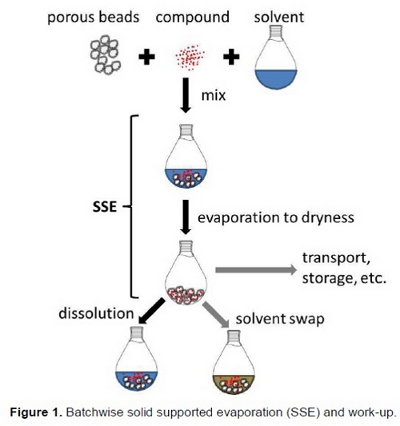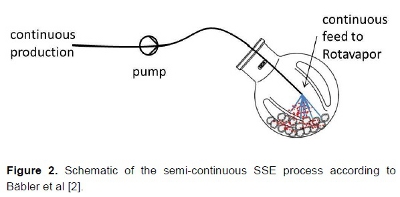Introduction
Solid Supported Evaporation (SSE) is a novel, facile method to isolate and store chemical products. In SSE the solute is absorbed inside a porous material – usually polypropylene (PP) beads. Therefore, the solvent is evaporated to dryness employing a Rotavapor and applying vacuum and heat.
 While the evaporated solvent is collected in the receiving vessel, the dry solute, e.g. a pharmaceutical intermediate, is trapped inside the beads that remain in the evaporation vessel (Figure 1).
While the evaporated solvent is collected in the receiving vessel, the dry solute, e.g. a pharmaceutical intermediate, is trapped inside the beads that remain in the evaporation vessel (Figure 1).
Compared to conventional evaporation to dryness, the trapped compound is protected from overheating by the beads. Hence, the beads act as a heat sink [2]. Applying optimized SSE conditions yields a high bead loading and freely flowing beads [1]. Important: sticking of dry compound to the vessel walls or dusts of fine powder is avoided by SSE.
The loaded beads are easy to handle, transport, and store. When needed, the compound is released from the beads by dissolution [1, 2]. In case of a solvent swap the trapped compound is dissolved in a different solvent than the starting solvent (Fig. 1). In theory, the solvents as well as the beads could be recycled.
Batchwise and semi-continuous SSE
In SSE it is aimed to absorb as much solute as possible on freely flowing polymer beads. Recently, Bäbler et al reported simple rules for the process optimisation and intensification, e.g how to avoid inter-clogging of beads [1, 2]. As a rule of thumb, clogging is avoided as long as the solute is soluble in the quantity of solvent swamped inside the pores of the beads. In batchwise SSE processes, crystallization on the outer shell of the beads, a reason for clogging, is minimized by a slow evaporation process [1]. 
The principle of the batchwise SSE was extended to a greater scale (kilo scale) by a semi-continuous process (Fig. 2). This process arrangement allows collecting reaction products and intermediates by SSE resulting from continuously operating mini- and pilot-plants without process interruption [2].
In semi-continuous SSE the solution is continuously pumped to the evaporation vessel filled with polymer beads. Feeding and SSE are continued as long as the beads are able to absorb solute. In contrast to the batchwise process, in semi-continuous SSE, a high solvent evaporation rate is advantageous in order to avoid sticking of the particles to the evaporation flask.
Conclusion
Evaporation to dryness by SSE is an attractive method avoiding thermal degradation of thermo-labile solutes and to obtain a freely flowing product. SSE could be an alternative choice to crystallization for product isolation on lab scale and pilot scale. We think that drying by SSE is an attractive concept to be considered in the constant improvement of early production processes in the pharmaceutical industry and the fine chemicals industry.
References
[1] M.L. Kebede et al, I&EC Reserach, 51, 41, 13445-13453, 2012.
[2] M.U. Bäbler et al, I&EC Reserach, 51, 45, 14814-14823, 2012.
www.buchi.com